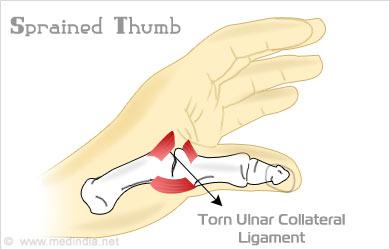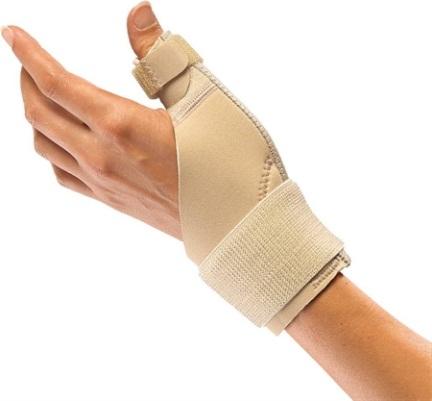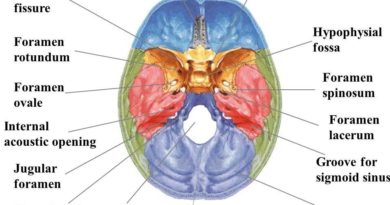Sprained Thumb
What Is a Sprained Thumb?
Sprained Thumb occurs when the tissue supporting the joint bones at the base of the thumb is injured or damaged. When there is a sprain on the thumb, the ulnar collateral ligament(UCL) which is found at the metacarpophalangeal joint (MPCJ)is the most affected. It might be partly or completely torn when an injury occurs resulting in the thumb being unstable.

A thumb whose main ligament is damaged may appear bent backwards or pointing away from the normal position. This usually occurs during sport activities whereby a player may fall on the thumb applying a lot of pressure on the thumb.
The most common case is during skiing where a player falls while holding onto a skiing pole and hence causing an injury on the thumb (Skier’s Thumb).Other games where such injuries would occur include rugby, netball and basketball. 2,3
Symptoms
If there is a sprain on the thumb, the patient may notice these symptoms:
- A sharp pain on the thumb that comes up suddenly at injury time
- You may notice a swelling on the thumb
- The thumb may become stiff and rigid to movement
- A feeling of laxity and instability especially when gripping something.
It is advisable to seek medical attention immediately after the injury as some serious cases where the UCL tears completely may require surgical procedures to restore the tissues to their place.
Diagnosis and Treatment
If there is potential damage to the thumb tissues, there is need to test for its stability by moving the thumb sideways or up and down at a medical center. Anesthetics are used for numbness since the moving the thumb can be very painful.
To check for broken bones at the joint, a stress x-ray is used to bring the image of the injured region as the thumb is being moved. A positive result from the x-ray may show an avulsion fracture which is a tear at the point where the UCL and bone connect.
Treatment can either be surgical or nonsurgical/ conservative depending on the severity of the injury.
Nonsurgical or conservative treatment
This is applied when the injury has not caused severe damage to the UCL which can easily be managed though after a while. Under this treatment, the following is done:
- Anti-inflammatory pills and ointments are prescribed to help relieve the pain
- Patients may undergo a cold therapy where they use ice packs to compress the swelling at the joint
- A splint is made and worn to support the injured ligament for almost 4-6 weeks before it is taken off
- Patients are advised to go for hand therapy balls to rest the stiffness of the thumb
- Therapeutic putty is also recommended in order for the thumb to regain its strength and dexterity
- Patients are also encouraged to do resistance exercises to improve on thumb’s ability to grip things

It is important to note that thumb stabilizers, splints and protection braces or tapes should not be removed until the recommended period is over. They can only be removed when the swelling on the joint has gone.
Surgical treatment
This is normally performed when the UCL has been damaged completely. It is only through surgery therefore, that broken bones may be put back to their place using either a screw or pin. Before the surgical process begins, an anesthetic is applied on the patient’s arm to numb it. The doctor then makes an incision on the skin where the UCL and repairs it with sutures.
After the operation the patient will put on a splint on the injured thumb for a certain period before going back for removal. Like in the nonsurgical treatment, patients who have undergone surgery are also advised to perform various exercises to fasten the healing process.
This process could help restore the broken ligament but may have its own repercussions such as:
- Infection – after a surgery you may notice a swelling on the affected area, oozing pus from the wound, unneglectable pain and fever. This may be as a result of infection during surgery or either it was not properly done. You should therefore report to your doctor immediately though it occurs in rare cases.
- Scarring – this may arise due to the cut that was made on the skin at the bottom of the thumb. Sometimes the scar may be painful which is referred to as a keloid or hypertrophic scar. It however goes away after some time.
- Pain – is common after any form of surgery. However, this can be managed through pain relievers as prescribed by the physician or surgeon.
- Swelling – this is due to the procedures during surgery and may take a while to go away. Patients are advised to wear a sling especially in the early days after surgery to help rest the swell.
- Stiffness– wearing a splint for a while after a surgery may result in the thumb becoming stiff and numb. However, hand therapy exercises will be of much.
Recovery
The healing process may take a while even up to months depending on the extent of the injury. This may leave many patients worried of when they can go back to performing their normal routines of work. In this case, the surgeon may be required to issue a certified note stating that a patient is fit to resume duty.
Patients often resume their work after two to three weeks but are not allowed to participate in heavy tasks as this would lead to re-injury. Those who drive are advised not to for a period of six weeks or until the surgeon has given an okay for them to drive again.
Athletes can resume their activity after four weeks but continue with their therapy sessions to ensure stability restoration.
The thumb may not gain its full stability as it was before and hence it may be a little bit weaker. However, it is very rare for the thumb to be permanently unstable or going for a second surgery. It is advisable also to frequent your doctor’s appointments for more information on handling a sprained thumb.
Prevention
As it is obviously known that prevention is better than cure, you are unlikely to have a sprained thumb if you do the following;
- If you are a goal keeper in soccer, a rugby player and football player, you should never go to the pitch without wearing a tape around your thumb. This will help protect your thumb and maintain its stability during the sport activity hence preventing any injuries on the UCL.
- Skiers should use a thumb brace when skiing
- Skiers are also advised not to put their hands inside the ski pole loop as this will put them at risk of injury
- Thumb stabilizers can also protect the UCL and players should use them regularly.
Reference List
- Sprained Thumb- Orthoinfo-AAOs. http://orthoinfo.aaos.org/topic.cfm?topic=a00022
- Ulnar Collateral Ligament Injury (skier’s thumb). https://www.stgeorges.nhs.uk
- Sprained Thumb (skier’s thumb) In Depth- Thumb and Wrist. http://www.physioroom.com/injuries/hand_and_wrist/thumb_sprain_full.php
- Sprained Thumb/ Symptoms and Treatment/Sportsinjuryclinic.net. http://www.sportsinjuryclinic.net/sport-injuries/wrist-pain/sprained-thumb


